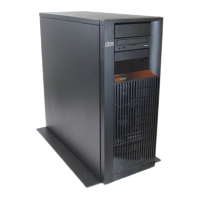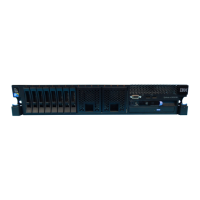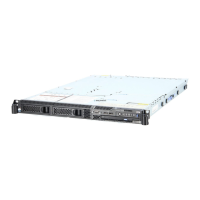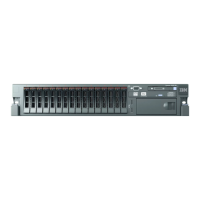v Yes: Move the cursor to another IOA assigned to the IOP, choosing IOAs with a status of
″unknown″ or ″disabled″ before moving on to IOAs with a status of ″operational.″ Go to step 14
(See page 91).
18. The failing IOA is located. Exchange the I/O adapter that you just powered off. Use the location you
recorded in step 14 to locate the IOA.
19. Power on the IOA that you just exchanged.
Does the same SRC that sent you to this procedure still occur?
v Yes: The IOA is not the failing item. Remove the IOA and reinstall the original IOA. Continue with
the next step.
v No: You have exchanged the failing IOA. Go to “Bus PIP verify - RA” on page 101.
This ends the procedure.
20.
No failing IOAs were identified. Return to the procedure that sent you here.
This
ends the procedure.
Bus PIP IOP-03: For use by authorized service providers.
Use this procedure to isolate a failing PCI I/O adapter card from an SRC.
Attention: The removal and replacement of all FRUs in this procedure must be performed using dedicated
maintenance.
1. Determine the ″PCI bridge set″ (multi-adapter bridge domain) by performing the following:
a. Record the bus number (BBBB), the multi-adapter bridge number (C) and the multi-adapter bridge
function number (c) from the Direct Select Address (DSA). See “Breaking down the SRC” on page
63 for help in determining these values.
b. Use the bus number that you recorded and the ″System Configuration Listing″ or ask the
customer to determine what frame the bus is in.
c. Record the frame type where the bus is located.
d. The PCI bridge set is the group of card positions controlled by the same multi-adapter bridge on
the bus that you recorded. Use the ″System Configuration Listing″, the card position table for the
frame type that you recorded, the bus number, and the multi-adapter bridge number to determine
the PCI bridge set where the failure occurred. Refer to the “Card positions” on page 65 (located in
the Bus PIP Overview topic) to locate the card position table for the frame type that you recorded.
e. Print out the Installed features in a PCI bridge set form.
f. Using the card position table, record the PCI bridge set card positions, and multi-adapter bridge
function numbers on the form.
g. Examine the PCI bridge set in the frame and record the information on the form for all of the
positions with IOP and IOA cards installed in them.
h. The IOP with a failing IOA is in the card position that matches the multi-adapter bridge function
number that you recorded in the DSA. In the ″IOP″ or ″IOA″ column of the form, write the word
″DSA″ next to the IOP that is identified in the DSA.
i. Using the form, start at the card position for the IOP in the DSA and search down the ″IOP″ or
″IOA″ column (increasing multi-adapter bridge function numbers) and mark each IOA with an ″X″
until you hit the next IOP or the bottom of the column. The IOAs that you marked with ″X″ are all
under the control of the IOP that is indicated in the DSA.
2. Did the SRC appear on the system control panel or the system console? (This would happen if the
system does not have multiple partitions, or if the failure occurred in the Primary partition of a system
with multiple partitions.)
v No: Continue with the next step.
v Yes: This procedure will instruct you to power off and power on the system or partition with the
problem. Perform that function as you would normally power off and power on the system.
Continue with step 4 (See page 93).
92 iSeries: iSeries Server 270, 800, 810, 820, 825, 830, 840, 870, 890, SB2, and SB3 Hardware Problem Analysis and Isolation
